
The ultimate guide to content marketing
At its simplest level, content marketing is the strategic process of creating valuable and relevant content that will attract and engage a target audience with the purpose of driving them towards profitable action.
But how does content marketing work? And more importantly, how can marketers leverage its magic like the 72% of businesses who say that great content is a major key to their marketing success?
In this definitive guide, we will provide you with a thorough understanding of what content marketing is, and teach you how to create a killer content strategy that will build authority with your target audience, boost the ranking of your website and earn more profit for your business.
1. What is content marketing?
Content marketing is a powerful tactic used to attract and engage with your target audience in a meaningful way. When done well, it builds brand authority, authenticity and awareness whilst nurturing consumers down the path to purchase. The Content Marketing Institute defines content marketing as:
“… a marketing technique of creating and distributing valuable, relevant and consistent content to attract and acquire a clearly defined audience – with the objective of driving profitable customer action.”
The assets used in content marketing can vary from blog posts, videos, whitepapers, webinars, podcasts, and many more. No matter what medium it takes, every piece of content must be created with the clear purpose of providing value and building loyalty with your audience so they trust you when you ask them to perform an action – such as purchase your product or service.
2. How does content marketing work?
Content marketing doesn’t just happen by accident. It is a strategic process that starts by defining exactly who your target audience is and then reaching that audience with the right message, at the right point in their buyer’s journey.
When done right, content marketing works in four key ways:
- It attracts an audience to your brand
- It engages that audience by providing upfront value
- It nurtures that audience through the decision making journey by providing meaningful information at each phase
- It delights the audience by providing an epic post-purchase experience that keeps them coming back for more
Content is a powerful tool that attracts, engages, nurtures and delights throughout the customer decision making journey, allowing brands to send powerful messages that achieve maximum influence at key decision-making moments.
The National Australia Bank uses these principles to acquire new customers and upsell products to existing customers through its blog, ‘Life Moments.’ Here is an example of one of its articles titled, ‘Keeping your money safe when you’re on holiday’.
The blog isn’t about travel loans, internet banking or debit cards but it does provide value to customers or prospective customers who’re about to travel overseas. It does this by teaching them how to keep their money safe throughout their holiday but also cleverly includes links to NAB products that the consumer would find useful when travelling.
This is content marketing in action. NAB’s blog attracts and engages an audience of soon-to-be travellers and then hits them with banking products suited to their needs at just the right time – when they’re planning a holiday.

Content creates brand awareness
High-quality content isn’t limited to directly acquiring new customers or creating revenue through existing ones. Content can simply be used to increase brand awareness and lifetime value. For example, French luxury brand Hermès has a following of nearly 10M on its Instagram account.
It is unlikely that this many people can afford to purchase their products, but the brand’s quirky videos, vintage artwork and whimsical copy engages the audience enough to keep up with them. There is no call to action suggesting to ‘Buy Now’, yet the value of the brand has increased because the audience enjoys feeling part of the Hermès story and are therefore likely to ‘share’ their content, furthering brand awareness and perceived value.
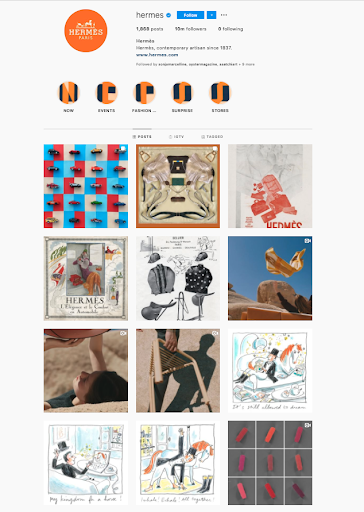
These examples give you an idea of how content marketing uses great storytelling to attract, engage and influence consumer behaviour; but there’s a lot more to the process than that.
For content marketing to create revenue it requires a tactical approach to distribution, reporting and customer acquisition. The first step in this analytical process is to understand the customer decision making journey.
3. Understanding the customer decision making journey
To create content that attracts, engages, nurtures and delights, you need a thorough understanding of the customer decision making process.
The sales funnel has evolved in recent years as customers have become more empowered by technology. Once, a marketer’s journey relied on one-way messages, but today things are different. Rather than television or radio being the primary source of information and advertising, consumers spend 8.8 hours of their day consuming digital content and conducting online research. Why does this matter? Because this instant and constant access to infinite information has empowered customers and made them less susceptible to traditional marketing tactics. Therefore, the customer decision making journey has had to evolve to keep up with these changing expectations.
Today, the customer journey progresses through five distinct stages which include Awareness, Initial Consideration, Active Evaluation, Closure and Post Purchase. Rather than turning to a sales consultant for guidance or advice, today’s customer is empowered to discover their own information at each stage of this journey. This means that as marketers we need to provide information (or content) at each stage to assist the consumer and gently nudge them toward our product, service or brand.
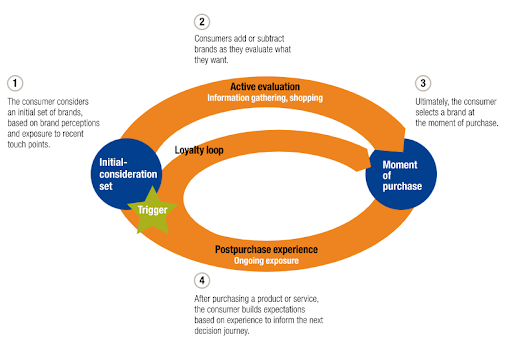
The 5 stages of consumer decision making
Awareness of a need
In many cases, a consumer may not be aware that they have a need until they are presented with its existence.
A pet owner for example, may not know that the hair being shed by their pooch is a common household allergen that could induce a bad reaction for an unsuspecting guest. That’s until they come across a blog on the subject which just happens to be written by a local vacuum cleaner supplier. The consumer is now aware that they have a problem and they’re beginning to consider how they can solve it.
In good news for the vacuum company, this early exchange of value increases positive brand associations prior to the time when critical purchasing decisions are made. This enhances the likelihood that their brand will eventually make it into their target customer’s shopping baskets.
But there’s also a more practical reason the vacuum cleaner company would want to produce this type of content. By attracting a user to owned assets such as a brand’s website, blog or social media channel, they can more efficiently reach them again with future marketing messages using retargeting or email campaigns.
Initial consideration
Before a consumer starts the conscious process of weighing up different brands that address the need they’ve just been made aware of, a subconscious mental process takes place that is crucial in determining the end purchasing result. This is known as the initial consideration stage of the customer journey.
To explain how it works, let’s use the example of our pet owner. They’ve just been made aware that they have an issue with hair in the house but they’re not sure what to do about it.
Without being aware of it, this event will kick start a thought process around vacuum cleaners that might look something like:
- ‘I’m sure that Dysons are the best – but I think they’re very expensive, I wonder if I can afford one’
- ‘I remember an ad for Hoover where they picked up a bowling ball with a vacuum cleaner, that could work for pet hair, for sure’
- ‘Mum has a Westinghouse model at home, I should look into that brand’
As you can see, before the consumer has even opened a search engine, they have an initial set of considerations in mind that are crucial in determining what sort of brand research they will undertake next. As a marketer, it’s important to consider this stage in your planning processes because you can influence a consumer’s initial consideration set and create accumulated experiences formed from touchpoints such as advertisements, top of funnel content and brand experiences. Why for example, does our consumer believe that Dysons are the best vacuum cleaner? Well, the truth is that this narrative has been strategically constructed by the Dyson company through clever word of mouth and content marketing campaigns that over the years have positioned them as the go-to name in luxury vacuum cleaners.
For our consumer, they are now taking Dyson, Hoover and Westinghouse with them as a shortlist of brands ready for the active evaluation stage of their journey.
Brands that use content to reach consumers in the initial consideration stage are 3x more likely to be purchased than brands who don’t.
Active evaluation
According to Adweek, 81% of shoppers conduct online research before making a purchase. This is known as the active evaluation phase of the buyer’s journey and is where consumers look to solve problems and answer questions. A consumer will most likely enter this stage with a few brands already in mind but what they’re really doing is seeking content that can thoroughly educate them and help steer them towards the best brand for their needs.
If you’re a vacuum cleaner brand this could be a blog titled ‘The easiest tips for getting rid of pet hair in your home’ or an ebook called ‘The Ultimate Guide to a Pet Friendly House’. There’s no guarantee that consumers who find this content are going to purchase from your business, but because the content is valuable to them, trust is developed and they are more likely to look favourably on you when they see case studies, reviews or video demonstrations aimed at getting them over the line and closing the deal.
Content that is often effective in the active evaluation stage includes:
- Detailed case studies
- Webinars
- Ebooks
- YouTube tutorials
- Review videos
- White papers
The good news for brands that didn’t make it into a consumer’s initial consideration set is that they can still interrupt the customer decision-making process in the active evaluation phase. While researching Dyson for example, the consumer may come across a great video review that explains how another brand the consumer wasn’t aware of does just as good a job at half the price and this will pivot the direction of their research.
Brands can take greater control of the active evaluation process by crafting clear pathways for loyal customers to create positive user-generated content such as reviews or product shout-outs.
Closure
Once a consumer whittles down their choices to one or two options, they’ve reached the closure stage of their journey and it’s time to seal the deal. This is where all the hard work that you’ve put into creating and nurturing a trusting relationship through relevant and valuable content pays off and it’s time to use strong touchpoints to steer them towards purchase.
In the closure stage, clear and direct CTA’s should be included in your copy as well as any appropriate marketing staples like ‘buy now’ buttons and email sign-ups. For many businesses, live demos, trial sessions and case studies are appropriate to use here with phrases such as ‘buy now’, ‘limited time only’ and ‘don’t miss out’ creating a sense of urgency, scarcity and social proof that will influence a customer to pull the trigger. In simpler terms, the consumer knows that your brand is the solution to their problem but they need you to give them the final nudge and prove that you’re the best (and often easiest) solution.
Clever closure stage content is especially important in ecommerce where the average store loses over 75% of sales to shopping cart abandonment. Research shows that by simply optimising check out design and content, $260 billion worth of ecommerce sales can be recovered from the sales process.
Post-purchase
The buying experience doesn’t stop after the moment of purchase. Modern consumers expect value to continue postpurchase and can even suffer buyers’ dissonance if they don’t receive after-the-fact proof that they made the right purchasing decision. Counteracting these feelings and turning consumers into brand advocates can be achieved with a postpurchase nurture program that provides continuous education about your business and products. Postpurchase content can include; how-to guides that give tips on how to get the best of your purchase, an engaging follow-up video series that keeps them excited and engaged or an invitation to exclusive events. All these initiatives result in higher customer satisfaction levels and are rewarded by customer advocacy and repeat purchases.
The psychology of why post purchase content works is simple. Your audience has recently engaged with you and is therefore more susceptive to your brand and message. This is evident in the success of ‘Thank you for your purchase’ emails which have open rates 2.5x better than the industry average.
It costs 5x more to attract new customers than it does to retain current customers. With the right nurture program, even if you only improve your retention rate by 5%, you can increase profit by at least 25%.
4. Creating your content marketing strategy
Now that you understand how the empowered consumer works in the context of the customer decision making journey, it’s time to start creating a content marketing strategy. A thorough planning process is essential for success, with marketers who proactively plan their projects 356% more likely to achieve their goals than those who don’t. Creating a content plan takes time – but the more research, data and creative thinking that goes into the initial planning process, the better quality your output, efficiency and success will be.
The 5 W’s of content marketing
Understanding your audience is essential to good content marketing, but so is having a clear understanding of your business and the purpose of your marketing efforts. Just like any inbound marketing strategy, content marketing relies on you discovering your ‘Why’. This can be a big task but a handy way to get started is to map out your 5W’s and consistently refer to them to keep your content targeted and on track.
The 5 W’s of content marketing:
- Who is my target audience?
- What actions do I want my target audience to take?
- Where should my content sit?
- When is the right time in the customer’s buyer’s journey to provide this information?
- Why am I doing this?
This will help you to create accurate buyers’ personas and journeys as well as set goals for the content you are going to write.
Who: Understanding your audience
Now it’s time to get a thorough understanding of your audience so that you know what their preferences are in context to their journey. This process starts by creating buyer personas based on market research done on your current consumers as well as through data-driven research on potential customers.
Buyer personas work by breaking down your customers into approximately three segments. While it can be tempting to create a large number of personas, this can actually be counterproductive and potentially confuse your efforts later down the track.
The first step in creating a buyer persona is research. Conduct a series of interviews that seek to reveal qualitative data about your audience that you can use to create a profile that can reference whenever you create content.
Valuable questions could include:
- Demographic information: age, gender, location
- Occupation: current job title, industry, career aspirations
- Influences: what influences the decisions they make in life and when making a purchase
- Pain points: what challenges are they facing in their career, family and everyday life
A single 29 year old male who lives in the inner-city with an entry-level position in finance will have a different data set to a middle-aged female business owner in the agricultural sector.
Once the data is collated, turn that information into persona cards that act as a semi-fictional representation of your ideal customer base, just like Enterprise Erin below:
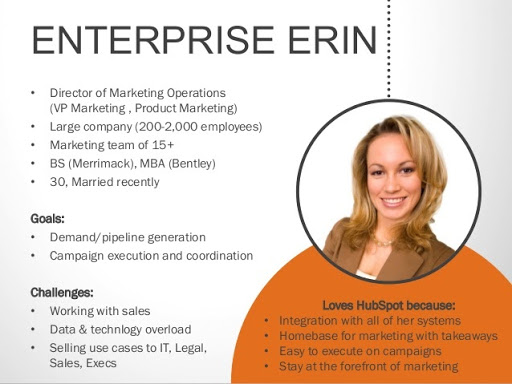
The personas that you create help predict the actions of your customers and understand why they are performing in a certain way when they interact with your content. They also help develop a tone of voice for your content so that the language you use for each persona reflects their lifestyle and maximises the effectiveness of your message.
Keep in mind that customers require different types of content at different stages in their buyer’s journey – so using the data you’ve learnt about the journey, combined with the insights you’ve gained on your customer is going to help you map the content types and messages you need to plan for.
What: Creating your content mission statement
A content marketing mission statement is a format for taking your learnings and using them to define how you will direct your strategy moving forward. It should be no longer than a sentence yet still captures the essence of your organisation and purpose. A content mission will help you keep sight of your goals and should be ideally printed out or kept somewhere that is easy to come back to and reference often.
The best way to create your content mission is to follow a template that answers the who, what and why of your content. The template below is a good reference for creating your own mission statement:
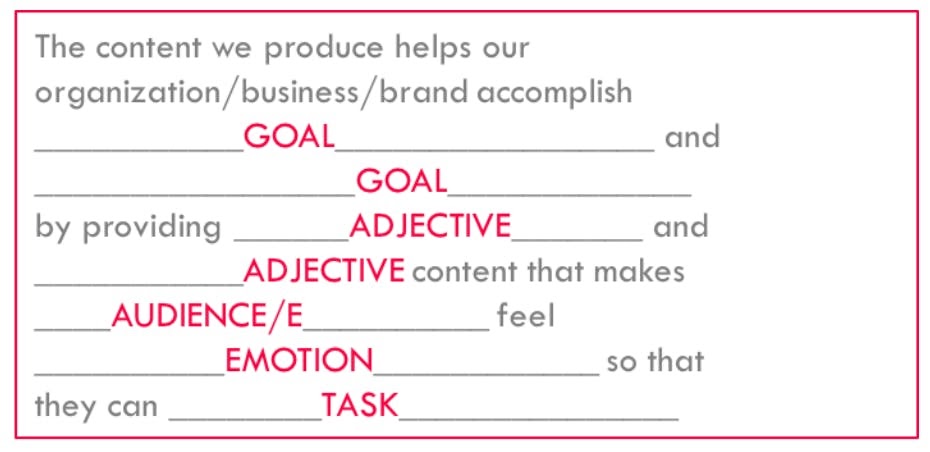
When/where: Building your distribution strategy
Even if you are an expert content writer capable of producing compelling copy relevant to your target audience; you aren’t going to see any results for your efforts if nobody views your work. Therefore, planning how you amplify your content is vital and will determine your effectiveness in building an engaged audience.
This means that before you post or send any of your content, you must create a distribution strategy. This will allow you to research and build an optimal channel plan and ensure that every piece of content you create fulfils its maximum potential.
There are three main components that make up your distribution strategy:
- Evaluate your distribution options
- Develop and document your channel plan
- Promote your content and amplify its impact
Evaluate your distribution options
Some brands mistakenly employ the “spray and pray” philosophy in which they post content as often and wherever they can thinking they will somehow magically land on a consumer who is receptive to their message. This type of distribution makes it nearly impossible for marketers to gauge the value of their content or track the results required to keep their strategy agile.
Evaluating the value of each of your distribution channels will help determine the best method for conveying your message to the right buyer persona at the optimal stage in their buyer journey.
Content distribution falls into the following categories:
- Owned media – channels that your brand has ownership and control of, such as your website, emails and newsletters
- Shared media – tends to be social media including LinkedIn, Facebook, Instagram and Youtube
- Paid media – is any content created by you and amplified through paid means such as native advertising, paid search, influencer marketing, paid social promotion
- Earned media – is any material written about your business that you haven’t paid for or created yourself. Traditionally, earned media was PR and news mentions, and while this is still the case, the definition has now expanded to include user-generated content such as online reviews, social media shoutouts and blog mentions
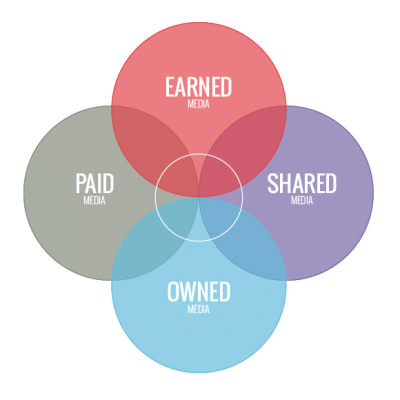
To create a truly optimised marketing strategy, ideally a mix of all four methods is required to remain competitive and increase your audience. But for brands who are just beginning their content journey, starting on a single owned-media channel that you have control over, such as a blog, will perfectly set up your home base for traffic and allow you to start building an engaged audience eager to follow you as you expand to other channels.
When deciding which channel is the most appropriate for different content pieces, consider the following factors:
- Audience characteristics – how will each persona engage with a channel. Instagram (shared media) for instance may be ineffective for a buyer persona in the 50+ age bracket yet perfect for a millennial audience
- Engagement – How susceptive would a particular buyer persona be to hearing from you weekly? Would they prefer image-based content because they’re time poor? Are there topics, such as pop culture, that would be off-putting for them?
- Communication style – What tone of voice works for each persona?
- Brand resources – What capacity does your team have for creating content? There’s no point planning for a weekly podcast if you don’t have the staff, resources or time to commit
Once you’ve put all these pieces together, you’ll have a solid understanding of what content you need to create to reach each persona in their journey. It also gives you the tools to audit your existing content to discover what can be repurposed, optimised or discarded.
Why: Defining your objectives
“If you don’t know where you are going, you’ll end up someplace else.”
– Yogi Berra
Without defined objectives, it’s impossible to keep your content plan targeted or measure the effectiveness of your initiatives. There are numerous strategies for creating content marketing objectives but a good starting point is to use SMART goals and make sure that they align with your overall marketing strategy.
SMART goals refer to the five elements that make up an objective. They are characterised by being specific, measurable, achievable, realistic and timely.

For example, you may have the marketing goal: “By December 31, 2020, the marketing team will reach 2,000 qualified leads every month.”
So how can you align your content marketing strategy with your overall marketing goals? Some good content marketing SMART goals may look something like:
- “Grow our email list by 25% by the end of the financial year.”
- “Increase our blog traffic by 10,000 visits in February.”
- “Reach 1,000 e-book downloads by the end of 2020.”
Each goal is highly specific, gives a timeframe for completion and can be measured and tracked throughout the period of the campaign.
5. Determining KPIs for your content marketing program
Determining the relevant KPIs required to measure the success of your content marketing plan will depend on the goals that you set out during your SMART research, but should always aim to prove the value of your content output.
The following KPIs are common metrics that content marketers use to assess their goals and are a good guide for creating your own:
- Overall traffic
- Time on page
- Click-through rate (CTR) of internal links
- Bounce rate
- Comments
- Social shares
- Links
- Organic rankings
- Leads
- Conversions
- Subscribers
- Customer lifetime value (CLV)
- Customer retention
- Customer acquisition costs (CAC)
- Overall ROI
There isn’t a one size fits all approach to creating KPIs and you may discover some new ones that you want to meet as you progress with your content plan. But the good news is that by simply setting goals and working methodically towards them, you are on the right path to successfully executing your content marketing plan.
6. Conducting a content audit
Knowing what content you already have in your inventory is essential for determining whether there is anything relevant to your target audience that can be reused or repurposed in the future. It’s also an essential exercise for analysing the success of previous campaign results to determine the feasibility of any future content projects you may undertake.
A content audit should aim to analyse all website, social media and landing pages and organise findings by:
- Content title
- Date
- Targeted buyer persona
- Buyers journey phase
- Content format
- Length
- Relevance
- Notes
A well-executed content audit may look something like this:
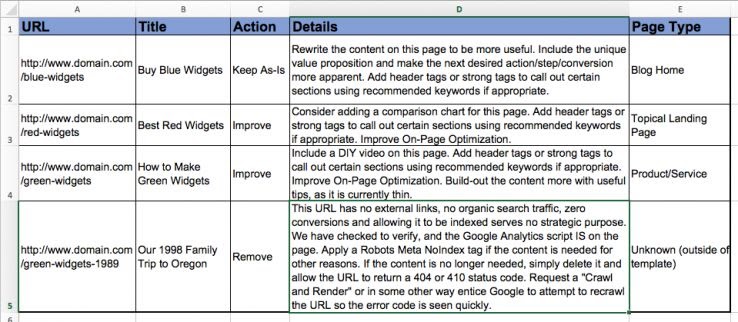
Analyse success metrics
Document how successful each piece of content was based on metrics relevant to each content piece. This could include:
- Number of page visits
- Social media shares
- Time spent on page
- Web traffic
- Social comments
- Conversion rates
Analyse your findings to determine what performed well and look for any patterns to help you craft your content strategy. What does your research tell you? If a blog had a healthy number of page visits but wasn’t shared by your audience on social media, could this be due to the lack of a ‘share’ button that allowed them to do so easily? Finding patterns like these should direct the content you create in the future and help you learn from mistakes made in the past.
After your existing content has been audited, you can conduct an event-based audit where you plan for upcoming product launches and work out what content could potentially be used to support these initiatives.
Performing a content audit will uncover possible content gaps on your website. By filling in these gaps, you can improve your SEO rankings as well as supplement your content strategy.
7. Creating your content calendar
After conducting an existing and event-based content audit, it’s time to create an editorial calendar to help strategise, organise and ensure consistency in your content plan.
A content calendar is a great organisational aid that will ensure your team is aligned and tasks are clearly defined. But it also acts as a strategic marketing tool that keeps your target audience at the centre of your thinking. It allows you to easily map out their requirements at each stage of the buyer’s journey and align that with upcoming events, product launches and overall business goals.
There are a number of online content calendars you can choose from. Many come with additional features such as automation, social media integration and inbuilt communication tools. But if you’re just getting started you can use a simple spreadsheet and design it for your requirements.
A content marketing spreadsheet may look something like this:
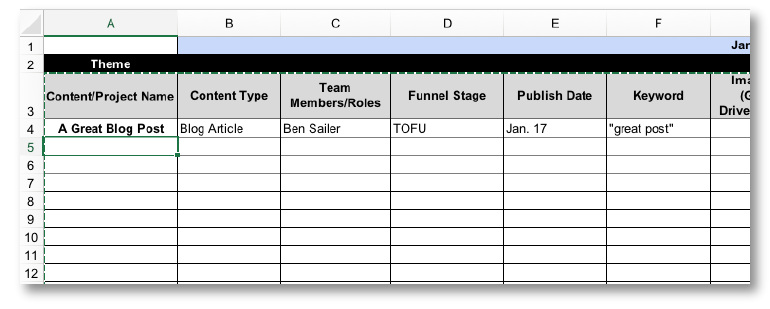
8. Types of content
The type of content you use within your marketing mix will differ depending on the goals of your campaign or overall strategy.
Different types of content can work for some brands but completely fail for another, so rather than just copying a competitor, use the data you’ve collected about your audience and buyers’ journey to drive your choices and remember to consistently track your results as you go. Don’t be afraid to use a process of A/B testing. Getting content marketing right can easily take 6-12 months and requires the agility to pivot a strategy if the results aren’t what you expected from your initial research.
Here are some of the main content types you can use in your content marketing strategy:
Blogs
Blogs are a key element to most content strategies today. Not only do ¾ of the internet say they read blogs regularly, but they are an easy and effective way to establish trust and expertise while delivering your message in a tone of voice that suits your organisation and target audience. They’re also a great tool for ensuring consistent communication is kept with your audience which can shorten the sales cycle as the consumer is being provided with the right information at the right phase of their buyer’s journey. When well written and optimised with relevant keywords, blogs can also benefit the SEO of a website. Every blog that you publish is an opportunity to build brand authority and attract a more qualified audience to your business. Let’s have a look at some of the different blogs that marketers use.
Types of blogs
Listicles: A listicle is characterised as an easy to consume article either partly or wholly formed by a list. Think, ‘Top 10 things to do in Melbourne’ or ‘5 reasons why content marketing is great for SEO’. One of the reasons they’re effective is that they allow readers to easily skim the information relevant to the questions they want answered, making the content more valuable to them.
Interviews: Effective for both the awareness and active evaluation stages of the buyer journey, interview-style blogs can be used to increase the authority of your brand. They work by partnering with industry influencers who have social capital and this association helps your brand establish itself as an industry leader in its own right. Interview blogs can be used in house as well. Interviewing stakeholders in your own business who have an interesting story to tell can position your business as thought leaders and humanise your company.
Guest blogging: Seeking collaboration with brands or individuals that already have an audience you want to reach will not only broaden your audience in the brand awareness stage but it will also strengthen your authority and give you the opportunity to use strategic links that will help improve SEO.
Longform content
One of your content goals could be to increase social media shares. Long-form content is a great way to achieve this goal because it allows you to thoroughly educate a reader about your topic within one post, which is highly valued by consumers. Longform content receives 68.1% more engagement on Twitter and 22% more on Facebook than standard-length blog pieces. It does however take time to put together and needs to be full of valuable links to reputable sources such as peer-review articles and studies. There’s no set rule about how long your blog should be but it’s generally agreed that 4,000 plus words is optimal. Due to its value, long-form content is also rewarded by Google which uses the length and quality links as indicators of authority.
Social media content
Whilst social media will be a distribution channel for some of your content, it can also be content in its own right. Instagram Stories and Facebook Live are examples of real-time content that can create brand awareness as well as nurture existing customers by keeping them updated with the happenings in your business. While these types of posts can feel spontaneous to the consumer, they still require research, a plan and a defined purpose that aligns with the rest of your content strategy.
When creating content for social media, think about how you can show your message rather than tell it. Consider how this clever example by Oreo shows their audience that a cosy night in is made better with their cookies.

Social media is also a great outreach tool. Use it to seek collaboration with brands or individuals that have a similar target audience to you. These mutually beneficial partnerships help expand your audience base and help optimise your content by incorporating content from an authoritative source in your industry.
Here are some content collaboration methods you can try:
- Simple mentions – if there’s a business that you share a potential audience with don’t be shy to mention them in your content.
- Contributor quotes – reach out to an expert in the field of the topic you’re creating content about for a quote that can be included in your body of text. Content is optimised when it includes people and pictures, especially people with high authority on a topic, so it will help increase site and social traffic. And remember: an ally in creating content will be an ally in promoting it
- Guest blogging – Guest blogging on other websites is a great way to build a bigger following on your own social media accounts and blogs, while also gaining credibility and networking opportunities
- Expert round-up – An expert roundup is a collection of quotes or interviews by influential people in your niche in answer to a specific question or topic. The pulling power of your experts results in increased website traffic, shares and engagement and positions your brand as an industry thought leader.
Infographics
Humans are visual learners. In fact, 90% of information transmitted to our brains is visual, which is why marketers often use visual storytelling techniques to grab the attention of their target audience and cut through the sea of online information they consume each day.
One way to accomplish this is through infographics, which are an eye-catching and informative method for showcasing data and analysis in an engaging and memorable format your audience can easily digest.

Quality infographics are liked and shared 3x more than any other type of content and can help accomplish your goals by:
- Grabbing the attention of your audience
- Making complicated data more understandable and relatable
- Demonstrating your expertise and creating credibility
- Boosting the value of your brand
- Making your content highly shareable
- Boosting the SEO of your website
Creating infographics can be an important element of your content strategy but it’s also a difficult skill that traditionally requires the expertise of a designer. The good news is that there are now plenty of great online tools that can help you create infographics with ease.
Canva, Visme and Easelly are all simple, accessible programs that allow you to create an infographic from scratch or from a template within their libraries.
Video
Video is now the no. 1 form of content marketing used worldwide, with 87% of marketers saying it’s a key element within their content marketing strategy. Video is fun, engaging and can be repurposed to use cross-channel. The same storytelling principles apply to video as they do to written content:
- Start with an idea and a script that answers the 5 W’s of content marketing
- Work out how to differentiate your idea from the over 8 billion videos that are viewed on Facebook each day
- Don’t use video as stand-alone content. It has to fit into the wider story that you tell about your brand or campaign
- Use multiple videos to piece together a whole story to keep the content timely
E-books
Like long-form content, ebooks are used to thoroughly educate your audience about important topics central to your brand. They’re a professional format for demonstrating your expertise and building authority and are considered an excellent lead generator. Think of it this way – any consumer who bothers to download an ebook is actively interested in something your brand is offering and can therefore be considered a highly qualified lead.
On top of this, because an ebook is often gated content, a marketer can use the download as a means of catching valuable information such as the email, location and demographic of that consumer. Using an ebook to generate leads is considered highly effective for many businesses. For example, Hubspot’s top lead magnet in 2017 was an ebook that was shared more than 12,000 times throughout the year.
E-books can help your content marketing strategy by:
- Generating leads
- Positioning your brand as a thought leader in the industry
- Offering valuable and specific information to your target audience
Creating a professional ebook is an investment, but if your brand can produce a high-quality resource, the ROI will be worth the effort. Ebooks can be turned into multiple derivative assets that can be used and repurposed throughout your different marketing channels and content. Their ability to be downloaded and read later is also considered highly valuable by the consumer.
White papers
White papers are in-depth, analytical reports that include a concrete, defendable argument in favour of a topic within your industry. Although white papers were traditionally used primarily for B2B campaigns, by 2018 35% of B2C businesses were also using them to help elevate their authority in the eyes of their customer base. White papers are also a great medium for showcasing original thought and publishing research conducted by your organisation.
Like ebooks, white papers are embedded into your website for download and are considered high-value for both the consumer, who feels like they are getting something tangible in exchange for their personal information and the organisation, who receives a quality lead full of rich information such as the consumer’s email address and profile.
Webinars
A webinar is an online educational session that can be watched live and is oftentimes made available to the consumer for later viewing. They increase online credibility and help to answer questions that your target audience has about your industry, business or products in a format that allows for deeper engagement and thoughtful Q&As.
This helps your audience resolve gaps in their knowledge while giving your business a greater insight into their needs. A webinar will generally focus on showcasing your businesses’ expertise on one topic at a time and aim to thoroughly educate attendees and eliminate any roadblocks they may have had on the path to purchase.

Podcasts
Over 30% of Australians listen to podcasts each month and the numbers are growing – which is why podcasts are an emerging trend with content marketers keen to make easily digestible and shareable content filled with high-value information. Podcast listeners are also classified as highly engaged and with remarkable retention rates, making podcasts highly beneficial for businesses that are trying to build a qualified audience.
Including podcasts in your content marketing strategy is a great platform for inviting guest speakers to come and share your brand’s message while capitalising on their audience pool. Guest hosts help build authority for your brand and the podcast will almost certainly be shared by themselves or their marketing team, furthering your reach and building your authority.
9. How content marketing builds brand authority and improves SEO
So far we’ve learnt that valuable, high-quality content drives profitable consumer action and builds the authority of your brand. But there is another process that complements and influences the success of your content marketing strategy.
Search engine optimisation (SEO) is the technical process that helps attract high-quality traffic to your content and wider website. The two work hand-in-hand and should always be planned with each other in mind.
Content and SEO work together to build brand authority in three key ways which in-turn work together to boost each other’s success:
- Bring in high-quality leads
- Show authority on a subject
- Improve website ranking
When most people think of SEO they think about keywords, and while this is an essential element to SEO, there’s more to the equation, including good UX design, internal and external links and the art of writing SEO-friendly content based on audience questions.
Keywords
Keywords are highly relevant, researched words that will help your content rank higher in search engine results (SERPs). In the past, it was common to ‘over optimise’ content by stuffing a page with keywords regardless of how illogical it made the copy.
However, the Google algorithm has evolved over time to better understand human language, as well as to place higher value on usability indicators such as time on site or page scroll depth. These changes mean that while including keywords that are relevant to a topic is still important, crafting a well-balanced article that meets the intent associated with a keyword is moreso.
Keyword research tools such as ahrefs help to analyse the most popular keywords related to your industry based on metrics like competition or volume. A good practice is to search for words directly related to your topic or industry. A good keyword research tool like ahrefs will give you a list of exact keyword matches, broader matches and even questions related to an initial set of seed keywords.
Analysing a keyword list like this and identifying themes or questions associated with a topic can be a good way to prepare your content outline. Keep a record of the keywords that informed your planning and then use them throughout your content, where appropriate.
Here’s an example of the sort of information a keyword research tool can tell you about the topic, ‘content marketing’:
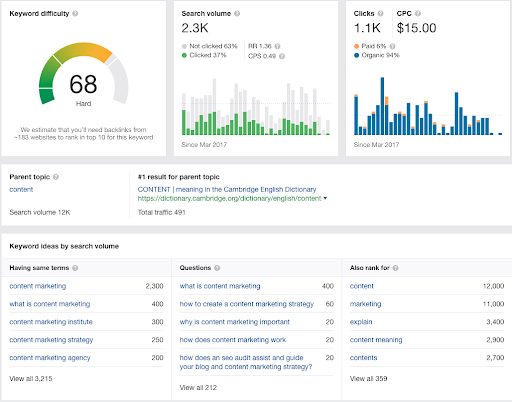
Answer the questions your audience is asking Google
Knowing which questions your target audience is asking Google about your product, service or industry is imperative for creating content that’s optimised for SEO and authority building. This makes sense given that content is ranked based on the value and relevance it has to an audience.
Using an SEO tool like ahrefs can help you craft these targeted questions, but it’s also valuable to conduct your own research and consider surveying your target audience for a true understanding of their unique requirements.
If you’re in the health and beauty industry for example, ‘Vitamin C serums’ have become a perennially trending topic amongst consumer-aged females. What sort of questions may the target audience ask search engines about serums that your beauty brand could then answer through content?
Through brainstorming or surveying consumers you might come up with:
- What are the benefits of Vitamin C serums?
- What are the best Vitamin C serum brands?
- Can I use Vitamin C serum instead of moisturiser?
These are great questions but interestingly, when ‘Vitamin C serum’ is entered into the ahrefs keyword tool the results were as followed:
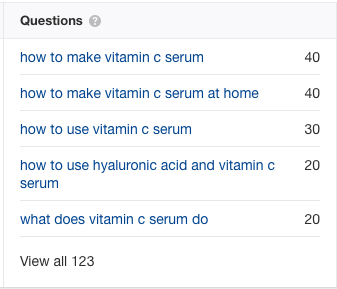
Through brainstorming, surveying and keyword research you now have a great set of relevant questions that can be answered through content and will in turn be rewarded by search engines. An optimal SEO strategy requires many more elements and learnings but as a beginner, researching appropriate keywords and answering questions your target audience has about your industry will greatly improve the SEO performance of your content.
Don’t be tempted to fill your content with overt advertising for your services. Psychologically, this breaks the trust your audience has with you and SERPs will penalise you. Instead, use strategic CTAs that link back to your website such as:
“Want to know more about how Vitamin C serum can help your skin glow? Contact our friendly team for a complimentary skin analysis, today.”
Content must be UX friendly
In content marketing, a good user experience (UX) doesn’t just refer to the readability and relevance of copy or keywords. It’s also about the technical optimisation of a page that ensures it’s appealing to search engines – and even audiences.
This means that content with enhanced metadata, appropriate tag use and free from broken links or error codes is essential for improving SEO and your standing as an authoritative source of information.
Using easy to navigate H1-H6 headings help readers to skim information that they need and keeps things well organised. All of these technical optimisation techniques help feed UX and will be rewarded by readers and search engines alike.
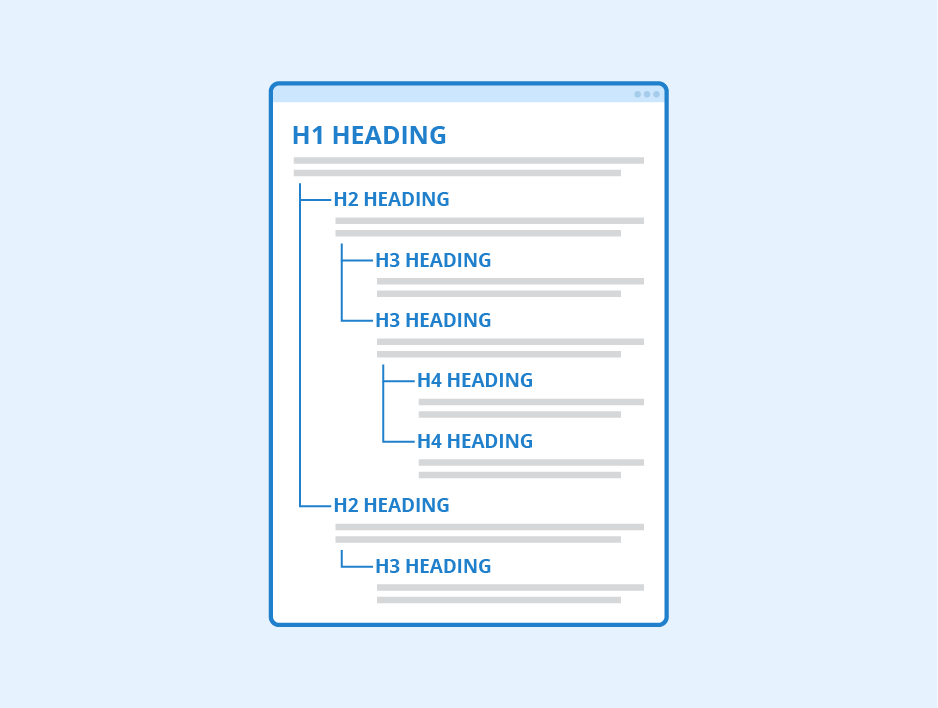
Strategic and logical hyperlinks help users move seamlessly to the next step in their buyers journey. A blog about the benefits of facial serums should logically link to a product page that prompts the consumer to fill their shopping cart. Good UX removes any friction in the buying process without a user having to navigate away from their screen.
Content marketing for link building
Link building refers to the process of other websites linking back to your website as a source of authoritative information. Considered a bread and butter element of many SEO strategies, the success of your link building efforts relies heavily on the quality of your content and whether you’ve leveraged relevant target keywords.
Also known as inbound or backlinks, link building is essentially a form of referencing another website that has high authority and can be likened to a popularity contest where the winner is crowned as the peak expert on a topic.
This is important for a brand for two reasons. Firstly, when Google knows that you are an authority on a subject it rewards you with a high search engine ranking. Secondly, the more authority you are perceived to have on a topic, the more likely your content is to be shared, furthering your reach and building your audience.
Here’s how content marketing attracts links to your website:
- When you create relevant, interesting and thought-provoking content, you are providing an opportunity for other brands to find, share and link back to you.
- Statistics, original research and infographics are considered the number one link building strategy of many SEO experts – by providing fresh and valuable industry insights, your work is likely to be referenced by many others who are interested in your niche.
- Content marketing gives you an opportunity to collaborate with other brands that share your target market, increasing your pool of potential link opportunities
- The higher quality your content is, the more you establish yourself as an industry authority, meaning more brands will link back to you
Creating valuable content assets such as white papers, infographics and well-researched blogs supported by statistics is only one piece of the puzzle. It is equally important for brands to get that information in front of the right people, which is why it’s essential to have a solid distribution and outreach strategy to support your efforts.
Creating opportunities for link building takes time and requires building relationships with key allies in your industry. But with the right planning, it’s achievable through initiatives such as guest blogging, reciprocal linking, website directory links and forum comments. As an added incentive, link building has the flow-on effect of increasing brand reach and assisting reputation management.
10. Content marketing statistics
The effectiveness of content marketing is backed up by statistics. Here are some of the top reasons why every brand should incorporate content marketing into their marketing mix.
- 55% of marketers say blog content creation is their top inbound marketing priority
- In fact, blogging is now so effective for inbound leads that according to Hubspot, they are among the primary three forms of media used in content strategies today.
- Marketers who prioritize blogging efforts are 13x more likely to see a positive ROI
- This is especially true for B2B businesses where 76% of B2B marketers are generating leads through blogging
- Over 409 million people view blog posts every month
- Content marketing gets 3x more leads than paid search advertising
- Small businesses with blogs get 126% more lead growth than small businesses without them
- Articles with images get 94% more total views
- Populating websites with blog content is how you end up with 434% more search engine-indexed pages than other business sites that don’t publish content.
- Web traffic is among the top two most-common measurements of success for content marketing strategies


